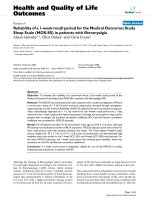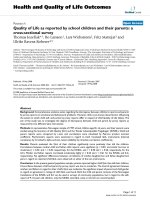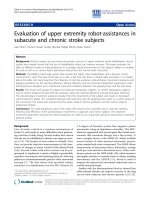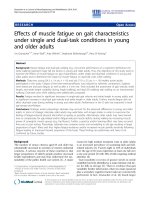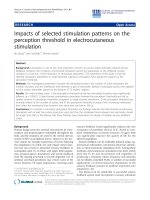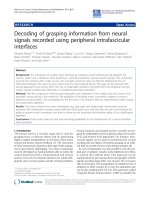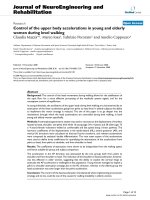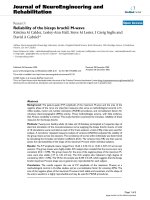báo cáo hóa học: " Reliability of voluntary step execution behavior under single and dual task conditions" doc
Bạn đang xem bản rút gọn của tài liệu. Xem và tải ngay bản đầy đủ của tài liệu tại đây (322.68 KB, 7 trang )
BioMed Central
Page 1 of 7
(page number not for citation purposes)
Journal of NeuroEngineering and
Rehabilitation
Open Access
Methodology
Reliability of voluntary step execution behavior under single and
dual task conditions
Itshak Melzer
1,2,3
, Irena Shtilman
3
, Noah Rosenblatt
1
and
Lars IE Oddsson*
1,4
Address:
1
NeuroMuscular Research Center, Boston University, Boston, USA,
2
Sargent College of Health & Rehabilitation Sciences, Boston
University, Boston, USA,
3
Dept Phys Therapy, Faculty of Health Sciences, Ben-Gurion University of the Negev, Beer-Sheva, Israel and
4
Sister Kenny
Rehabilitation Institute, Sister Kenny Research Center (12101), 800 E. 28th St. Minneapolis, MN 55407, USA
Email: Itshak Melzer - ; Irena Shtilman - ; Noah Rosenblatt - ;
Lars IE Oddsson* -
* Corresponding author
Abstract
Background: The current study investigated the repeatability (test-retest reliability) of ground
reaction force parameters recorded during a voluntary step execution under single (motor task)
and dual task (motor and cognitive task) conditions for healthy adults and elderly individuals as well
as the number of trials required to produce repeatable results.
Methods: Twenty-four healthy adults (21–63 years old) and 16 elderly adults (66–87 years)
performed a voluntary rapid step execution following a tap on their heel while standing on a force
platform under single and dual task conditions on three separate occasions. The first two tests
were performed 30–60 minutes apart and the third test was performed a week later. Variables
analyzed from the ground reaction force data included onset latency of step initiation (initiation
phase), preparation and swing phases, foot-off and foot-contact times.
Results: Intraclass correlation coefficients (ICC(2,1)) were good to excellent across all parameters
and test conditions for the pooled population and for elderly (0.74–0.92 and 0.62–0.88,
respectively) except for the swing phase duration where lower values were seen (0.54–0.60 and
0.32–0.64 respectively). Values were similar under single and dual task conditions.
Conclusion: A voluntary step execution test, performed under single and dual task conditions
especially foot-off and foot-contact times, is a reliable outcome measure that may be a useful tool
to asses dynamic balance function for diagnostic purposes as well as clinical intervention trials.
Background
Postural control plays a fundamental role for our ability
to maintain balance during various activities of daily liv-
ing especially those that include elements of independent
standing and gait. Age-related deterioration of the pos-
tural control system can lead to balance impairment and
limitations of mobility causing disability that may con-
tribute to falls. Falls are the leading cause of injury-related
visits to emergency departments and the primary etiology
of accidental deaths in persons over the age of 65 years [1-
4]. Nearly 30% of elderly individuals over 65 and almost
50% of elderly individuals over 80 fall at least once every
Published: 29 May 2007
Journal of NeuroEngineering and Rehabilitation 2007, 4:16 doi:10.1186/1743-0003-4-16
Received: 22 September 2006
Accepted: 29 May 2007
This article is available from: />© 2007 Melzer et al; licensee BioMed Central Ltd.
This is an Open Access article distributed under the terms of the Creative Commons Attribution License ( />),
which permits unrestricted use, distribution, and reproduction in any medium, provided the original work is properly cited.
Journal of NeuroEngineering and Rehabilitation 2007, 4:16 />Page 2 of 7
(page number not for citation purposes)
year [3]. Various postural responses including rapid exe-
cution of a step may prevent a fall from occurring [5]. Pro-
tective stepping [6], a perturbation-triggered automatic
response that is not under direct volitional control, can
quickly increase the base of support to help maintain
equilibrium [6,7]. In addition, rapid voluntary stepping
can help prevent the occurrence of a fall [8], especially
under circumstances when there is no distinct postural
perturbation but rather a gradual change in posture. Slow
postural changes could occur during various activities of
daily living such as walking, rising from a chair, tripping
or tangling of the feet, as well as during reaching move-
ments, stumbling on a carpet, rug or inappropriately
placed furniture or cords, circumstances under which the
majority of falls occur in the elderly population [9,10].
The faster a step is executed in these situations the lower
the risk of a fall would be thereby providing a rationale for
using measures of rapid voluntary step execution as a
potential indicator of the ability to avoid falls [8].
In a real life situation, the need to rapidly step to prevent
a fall would likely occur when attention is not directly
focused on performing a motor task but rather on a cog-
nitive task such as reading a street sign or watching traffic.
Simultaneous performance of cognitive and postural tasks
has been suggested as a potential contributor to instability
and falls [11,12] and there is evidence that attention-
demanding tasks have an effect on postural control in
aging [13]. Therefore, it seems reasonable to hypothesize
that falls are not due to balance deficits in isolation, but to
the inability to effectively allocate attention to balance
under multi-task conditions [14,15] possibly due to poor
executive function, commonly seen in elderly subjects
[16]. Further support for this view is provided by results
showing more than a doubling of time to initiate a volun-
tary step under dual as compared to single task conditions
in healthy elderly subjects following a cutaneous tap stim-
ulus compared to a 34% increase in young subjects [8].
During a voluntary step execution test the duration of var-
ious temporal phases extracted from the ground reaction
force can provide information regarding executive func-
tion (Initiation Phase – time from stimulus to beginning
of mediolateral weights shift prior to any movement),
associated postural control in preparation for the step
(Preparation Phase – time from Initiation Phase to foot-
off) and muscle power output (Swing Phase – time from
foot-off to foot contact) [8]. The sum of these three phases
is equal to the foot contact time, the overall time to exe-
cute the step following the initial cutaneous cue. From a
clinical view the foot contact time as a parameter may pro-
vide important information regarding an individual's
ability to resist a fall in a given situation, whereas the dif-
ferent phase durations may indicate specific deficiencies
in the performance profile of the step.
The aim of the present study was to investigate inter- and
intratester reliability of the temporal parameters assessed
during a Voluntary Step Execution Test [8] under single
and dual task conditions, i.e. simultaneous performance
of a motor and a cognitive task. We also investigated the
number of trials required to obtain repeatable results. If
step execution time is related to fall risk, this information
may be of use in a clinical or laboratory setting to assess
step execution performance or to evaluate effectiveness of
rehabilitation of postural control and balance function.
Methods
Subjects and procedure
Twenty-four healthy adult subjects (mean, 36.5 ± 15.5,
range, 21–63 years old) and sixteen healthy elderly sub-
jects (mean, 77.6 ± 6.6 years, range 66–87 years old) were
recruited for the study. Elderly subjects were included
based on the following criteria: no previous neurological
or orthopedic disorders, a score greater than 45 on the
Berg Balance Scale [17], a Mini-Mental Score [18] greater
than 24 indicating the absence of moderate to severe
dementia, absence of serious visual impairment or color
blindness, and the ability to ambulate independently (use
of cane allowed but not walker). Elderly subjects without
balance impairment were chosen since age-related deteri-
oration of balance function, affects all elderly individuals
[19]. This may lead to an increased risk of falling even in
healthy elderly persons, therefore, a better way to evaluate
and than decrease the number of fall-related injuries in
the elderly may be to also direct preventive efforts towards
elderly individuals who have not yet fallen.
All subjects provided informed consent, in accordance
with approved procedures by the Boston University
Charles River Campus IRB and by the Helsinki ethics com-
mittee at Soroka Medical Center and Ben-Gurion Univer-
sity of the Negev, Israel. All subjects, apart from two
subjects of the younger group, participated in two separate
data collection sessions separated by one week. To assess
intertester reliability, voluntary step execution behavior
under single and dual task conditions were tested 30–60
minutes apart by two trained raters (Rater 1, or Rater 2)
then by Rater 3. Raters were blinded to each others results.
Also, intratester reliability of voluntary step execution
behavior under single and dual task conditions was
assessed by testing subjects one week apart, by the same
raters (#1 and #2) testing the same subjects. The rater was
blinded to results from the previous week and the results
were not communicated to the subjects.
Instrumentation and data analysis
A portable Kistler 9287 force platform was brought to the
community dwelling center to measure center of pressure
(COP) and ground reaction force data during each step
execution trial. Force data were sampled at a frequency of
Journal of NeuroEngineering and Rehabilitation 2007, 4:16 />Page 3 of 7
(page number not for citation purposes)
100 Hz and stored for later off-line analysis [8]. Subjects
were instructed to adopt a standardized stance with their
feet abducted 10 degrees and their heels separated medi-
olaterally by 6 cm [20,21]. The repeatability of foot posi-
tion between trials was controlled through the use of a
rigid template that forced the feet into the proper position
at the start of each trial. The template was removed prior
to the start of data collection. Stepping foot was the same
for all trials and chosen by the subject. Subjects knew
beforehand which foot to step with and in which direc-
tion to step. Three forward and three backward stepping
trials were performed in a randomized order for each of
the two task conditions. During the single task trials, sub-
jects were asked by the rater to view an 'X' projected at eye
level onto a wall 3 meter in front of the subject (Figure 1,
left). Subjects were instructed to stand evenly on both feet
and to step as quickly as possible following a distinct tap
on the heel of the stepping foot provided manually by the
rater using a 30 cm long foam-padded wood baton. Sub-
jects were allowed to practice to become familiar with the
test situation and to ensure step clearance of the force plat-
form.
Following completion of the six single task trials, subjects
repeated the protocol under dual task conditions perform-
ing a modified-Stroop test [22]. The modified-Stroop test
consisted of a 5 by 5 matrix with names of colors where
the color of the ink was always different from the name of
the color. For example, the word "red" was printed in yel-
low ink. Subjects were asked to step as quickly as possible
from the force plate while reading out loud the color of
the ink of the projected color name. The modified Stroop-
test was used because it requires focused attention and few
instructions to perform. In addition, it requires only direct
verbal responses and it does not address memory, which
may be impaired in the elderly. After completion of all
twelve trials (six single task and six dual task trials) with
the Rater 1 and Rater 2 subjects were given a 30–60
minute rest period. Following rest, the protocol was
repeated with Rater 3 to complete the first test session.
Subjects returned within a week for the second test session
and the test protocol was repeated by Rater 1.
Force platform data were analyzed using code written in
Matlab (Math Works Inc, Cambridge, MA, USA) [8,23] to
extract five different temporal parameters: step initiation,
preparation and swing phases, foot-off time and foot con-
tact time (Figure 1, right). The tap cue was detected as a
spike (greater than three standard deviations from the
average baseline noise) in the ground reaction forces in
the anteroposterior direction. Step initiation was defined
at the first mediolateral deviation of center of pressure
(COP) towards the swing leg (greater than 4 mm from the
average baseline sway prior to tap). The step initiation
phase was calculated as the time from tap onset to step ini-
tiation. Foot-off time was defined by a sudden change in
the slope of COP towards the stance foot in the medi-
olateral direction. Foot-contact time was defined as the
onset of unloading in the vertical ground reaction forces
[24]. The preparation phase was defined as the time from
step initiation to foot off and swing phase was calculated
as the time from foot-off to foot- contact [8]. Each of the
five temporal parameters was determined for each of the
twelve trials for both raters and sessions. An average of
each event across all six trials during two different condi-
tions: single task and dual task was used to represent each
subject.
Shapiro-Wilk's statistic was used to test normality of the
variables for pooled population and for both groups [25].
The effects of age and task condition on the mean depend-
ent variables were calculated with SPSS (version 10.1, Chi-
cago, IL) using a two-way repeated-measures analysis of
variance (ANOVA) that included group (adults – elderly
adults) as the between subjects factor with repeated meas-
ures on the within subjects factors of task (single – dual).
Wilcoxon's signed rank test and Mann-Whitney U-tests
were used in case the variable was not normally distrib-
uted. The dependent variables were; Step Initiation Phase
duration; Time to Foot-off; Time to Foot-contact; Prepara-
tory Phase and Swing Phase durations. A significance level
of 0.05 was used.
Once the timing of the five temporal events was deter-
mined, inter- and intratester reliability was assessed using
a two-way random model for intraclass correlation coeffi-
cient (ICC) [26]. We used ICC(2,1) which assumes each
subject is assessed by each rater and the raters are ran-
domly selected and reliability calculated from a single
measurement. Intertester reliability compared the results
of the first and second testers from the first session; addi-
tional intratester reliability test compared the results of
Photo of the experimental set-up showing an example of for-ward Step Execution Test being performed under during sin-gle task conditions (left)Figure 1
Photo of the experimental set-up showing an example of for-
ward Step Execution Test being performed under during sin-
gle task conditions (left). Example of step execution data
(right). Fy = Ground reaction forces (shear forces) in antero-
posterior direction. Fz = Vertical ground reaction forces,
COPx = Mediolateral center of pressure, N = Newton, mm
= Millimeter. The following events are marked with X
; Tap
cue (C); Initial deviation of COPx
(A); Foot-off (FO); Foot
contact (FC). Note that the tap cue is detectable in any of
the signals. See text for further details.
Fz (N)
0
500
Fy (N)
0
0
COP (mm)
-200
+200
-100
+100
C
A
FO
FC
Journal of NeuroEngineering and Rehabilitation 2007, 4:16 />Page 4 of 7
(page number not for citation purposes)
the tests during the first and second session. Three popu-
lations were considered: elderly adults (N = 16), adults (N
= 24) and a pooled population consisting of all subjects
(N = 40). For each population, ICC(2,1) was determined
for each of the five temporal events during each of the two
test conditions, without regard for direction (overall step-
ping). The following guidelines were used when interpret-
ing ICC magnitudes: ICC < 0.4 represents poor reliability,
0.4 ≤ ICC ≤ 0.75 represents fair to good reliability, and
ICC > 0.75 represents excellent reliability [26]. Cron-
bach's alpha was calculated to estimate internal test con-
sistency using reliability analysis procedures in SPSS.
Results
Each subject performed 36 trials (12 trials × 3 sessions) 18
of which were under single (6 trials × 3 sessions) and 18
under dual task conditions (6 trials × 3 sessions). Two
subjects of the younger adults group did not perform the
third session due to illness. Table 1 shows average values
of the temporal step parameters across all three test ses-
sions for both elderly and younger adults under single and
dual task conditions, all step parameters except for swing
phase duration were normally distributed (Shapiro-Wilk's
statistic not significant) for the pooled population and for
each age group. In agreement with previous work [8] there
were statistically significant differences between the
younger group and elderly individuals across all step exe-
cution parameters for both task conditions (marked with
* in Table 1). With the exception of the swing phase in the
younger group, there was a statistically significant within
group increase in all other parameters under the dual task
condition (marked with + in Table 1).
Intertester reliability across all step parameter except for
the swing phase ranged between 0.74–0.89, for Rater 1 vs.
Rater 3 and between 0.74–0.84, for Rater 2 vs. Rater 3
under single task condition and 0.75–0.86 and 0.77–0.82
under dual task conditions, respectively. These were not
significantly different which allowed pooling of the
results for Rater 1 and Rater 2. Furthermore, ICC values
across all step parameter except for the swing phase,
between forward and backward stepping direction under
either single or dual task conditions were similar (0.70–
0.89 and 0.66–0.90, respectively) which allowed pooling
of results across the two step directions.
Intertester reliability
Table 2 shows ICC's for intertester reliability across both
step directions for all temporal events during single and
dual task conditions. Intertester ICC values for the pooled
population (N = 40) were excellent (0.79–0.88, p <
0.0001) for both single and dual task stepping conditions
with the exception of a somewhat lower value, yet statisti-
cally significant, for the swing phase under single and dual
task conditions (ICC = 0.60, p < 0.0001 and ICC = 0.55, p
< 0.03 respectively). ICC values for the elderly group were
good to excellent for all parameters across both test con-
ditions (0.70–0.83, p < 0.001, Table 2) with the exception
of ICC for the swing phase under dual task conditions
which was poor and not statistically significant (ICC =
0.32, p = 0.11, Table 2). Similarly, ICC values for the
younger adult subjects were good to excellent (0.68–0.88,
p < 0.000, Table 2) except for ICC's of the swing phase in
single and dual stepping, which were fair to good and sta-
tistically significant (ICC = 0.46, p = 0.01 and ICC = 0.77,
p < 0.000, respectively, Table 2).
Foot-contact and foot-off times showed the highest ICC
values for elderly persons under both single and dual task
conditions (0.82–0.82, p < 0.000 and 0.74–0.83, p <
0.000 respectively). The highest values for internal test
consistency were also found for foot-contact and foot off
times (Cronbach's alpha, ranged between 0.85 and 0.91),
whereas the lowest were for swing phase duration (Cron-
bach's alpha, between 0.48 and 0.78).
Intratester reliability
ICC values for intratester reliability of the elderly, younger
adults and pooled subject groups across both step direc-
tions and for both task conditions are shown in Table 3.
For the pooled populations, ICC values were good to
excellent (0.74–0.92, p < 0.001, Table 3) with the excep-
tion of the swing phase (0.48 and 0.54 for single and dual
task conditions, respectively). For elderly individuals the
ICC values were good to excellent, ranged from 0.74–0.88
for single task and somewhat lower 0.62–0.85 for dual
task (Table 3), but for the swing phase of both single and
dual tasks where values were poor although statistically
significant (0.47 and 0.42, respectively, p < 0.05, Table 3).
Table 1: Mean of step execution parameters for younger and
elderly adult subjects
Elderly Adults Younger adults
Single task
Initiation Phase 205 ± 55 * 135 ± 25
Preparation Phase 420 ± 75 * 340 ± 62
Swing phase 371 ± 145 * 283 ± 48
Foot off time 625 ± 119 * 475 ± 78
Foot contact time 996 ± 223 * 758 ± 112
Dual task
Initiation Phase 433 ± 158 *
+
186 ± 51
+
Preparation Phase 470 ± 105 *
+
364 ± 50
+
Swing phase 391 ± 144 *
+
281 ± 61
Foot off time 902 ± 236 *
+
550 ± 76
+
Foot contact time 1294 ± 332 *
+
831 ± 119
+
Values shown represent averages from the 1
st
measurement session
in milliseconds for single (6 trials, 3 forward + 3 backward) and dual
task (6 trials, 3 forward + 3 backward) ± 1 standard deviation. *
Indicates statistically significant differences between age groups and
+
between task conditions within age groups, respectively (p < 0.05).
P-value compares swing phase means ( ± 1 Standard Deviation)
between the two groups were measured using Wilcoxon test and
Mann-Whitney U test.
Journal of NeuroEngineering and Rehabilitation 2007, 4:16 />Page 5 of 7
(page number not for citation purposes)
For the adult group ICC's were excellent (0.76–0.93, p <
0.000, Table 3) except for the swing phase under single
and dual task conditions (0.41, p = 0.006 and 0.54, p <
0.000, respectively).
As for intratester reliability, foot-off time showed the
highest and most consistent ICC values for elderly per-
sons, under both single and dual task conditions (0.88
and 0.85, p < 0.000, respectively) as well as the highest
internal consistency (Cronbach's alpha, 0.92 and 0.94,
respectively). The lowest values were found for swing
phase duration (Cronbach's alpha, between 0.59 and
0.64).
Effect of trial repetition
Figure 2 shows average foot-off time for single and dual
task conditions for both populations of subjects across all
three test session. Overall, ICC's for foot-off time were
highest across all parameters and conditions and were
excellent (0.79–0.93), apart from 0.68 in dual task step-
ping for the younger group. During the 1
st
test session
there was a non-significant (p = 0.12) decrease in the aver-
age dual task foot-off time for elderly subjects from 1050
ms for the 1
st
trial to 827 ms for the 6
th
trial with the larg-
est change seen between the 1
st
and the 2
nd
trial (Figure 2).
An hour later during the 2
nd
test session no learning
period observed, the average foot-off time for the 1
st
trial
was 808 ms and 820 ms for the 6
th
trial. A week later, dur-
ing the 3
rd
session the foot-off time for the 1
st
trial was 911
ms and decreased to 827 ms (p = 0.15) for the 6
th
trial. For
the younger group the foot-off time under dual task con-
dition was approximately 500–550 ms across all trials
with no noticeable decrease in duration across trials. No
significant changes in foot-off time were seen during sin-
gle task stepping for either age group.
Discussion
Results from the current study provide show that Step Ini-
tiation Phase duration, Time to Foot-off, Time to Foot-
contact, Preparatory Phase extracted from the ground
reaction force during a voluntary step execution have
good to high intra- as well as inter-tester reliability across
Table 3: ICC values for intratester reliability
IPD PPD SPD FOT FCT
Single Task Elderly N = 16 0.77*** 0.83*** 0.47* 0.88*** 0.74***
Younger N = 22 0.86*** 0.88*** 0.41** 0.91*** 0.76***
Pooled N = 38 0.86*** 0.86*** 0.48*** 0.91*** 0.79***
Dual Task Elderly N = 16 0.73*** 0.62** 0.42* 0.85*** 0.71***
Younger N = 22 0.84*** 0.79*** 0.54*** 0.93*** 0.85***
Pooled N = 38 0.86*** 0.74*** 0.54*** 0.92*** 0.86***
Table 3 shows ICC(2,1) values and significance levels (in parenthesis) for intratester reliability (Rater 1 test #1 vs. Rater 1 test #2) for step
execution parameters Initiation Phase Duration (IPD), Preparatory Phase Duration (PPD), Swing Phase Duration (SPD), Foot-Off Time (FOT) and
Foot-Contact Time (FCT) under single and dual task conditions calculated separately for elderly subjects (N = 16), younger adult subjects (N = 22)
and the pooled population of elderly and younger adult subjects (N = 38). An average of all six step trials (three forward and three backward) was
used in the analysis.
Table 2: ICC values for intertester reliability
IPD PPD SPD FOT FCT
Single Task Elderly
N = 16
0.79*** 0.76*** 0.64** 0.82*** 0.82***
Younger
N = 24
0.70*** 0.78*** 0.46** 0.79*** 0.78***
Pooled
N = 40
0.86*** 0.81*** 0.60*** 0.87*** 0.84***
Dual Task Elderly
N = 16
0.70*** 0.70*** 0.32 ns 0.83*** 0.74***
Younger
N = 24
0.73*** 0.88*** 0.77*** 0.68*** 0.82***
Pooled
N = 40
0.79*** 0.82*** 0.55* 0.88*** 0.86***
Table 2 shows ICC(2,1) values and significance levels (in parenthesis) for intertester reliability (Rater 1 vs. Rater 2) for step execution parameters
Initiation Phase Duration (IPD), Preparatory Phase Duration (PPD), Swing Phase Duration (SPD), Foot-Off Time (FOT) and Foot-Contact Time
(FCT) under single and dual task conditions calculated separately for elderly subjects (N = 16), younger adult subjects (N = 24) and the pooled
population of elderly and younger adult subjects (N = 40). An average of all six step trials (three forward and three backward) was used in the
analysis (ns – not significant, *p < 0.05, **p < 0.01, ***p < 0.001).
Journal of NeuroEngineering and Rehabilitation 2007, 4:16 />Page 6 of 7
(page number not for citation purposes)
age groups under both single and dual task conditions.
Furthermore, ICC values were independent of step direc-
tion allowing pooling of these data. For the elderly popu-
lation, foot-off and foot-contact time ICC's were good to
excellent under both single and dual task conditions
(0.68–0.93). The lowest ICC values for the elderly group
were seen for the swing phase (0.32–0.77). Previous stud-
ies have demonstrated that voluntary step execution is
sensitive to the effects of age [8,24] and diseases including
hemiparesis [27] and Parkinson's disease [28,29]. Conse-
quently, parameters of a simple voluntary step execution
test may be a useful and reliable clinical test measure of a
functional task that involves a requirement of balance.
The magnitude of reliability we found was equal to or
higher than Intraclass correlations coefficients (ICCs) of
physical performance and physiologic assessments
reported by Wolinsky's et al. [30]. They tested eighty sub-
jects aged 50 to 65 between 5 and 45 days after a baseline
test and found ICC's of 0.81 for grip strength, 0.72 for
chair stands, 0.56 for gait speed, 0.60 for one-leg stand,
0.52 for semitandem stand, 0.58 for tandem stand with
eyes closed, and 0.27 for tandem stand with eyes open.
More recently, Curb et al. [31] found good reliability for
one-leg stance (0.69), 10-foot walk (0.59) and Rapid 10-
foot walk (0.57) in a sample of 203 Japanese Americans
aged 35 to 55 and 56 to 71 years old and without signifi-
cant functional impairments. They also found high relia-
bility for the 6-minute walk (0.90) and timed chair stands
(0.80 for 5 stands and 0.84 for 10 stands) Sherrington and
Lord [32] investigated the test-retest reliability of meas-
ures of strength, balance, gait and functional performance
in 30 elderly subjects following hip fracture. They found
high ICC (3,1) values for hip abduction strength (0.75–
0.86), hip flexor strength (0.66–0.80) and knee extensor
strength (0.68–0.94). ICCs for postural sway measures
ranged 0.59–0.89 for single leg stance. For the step test
they found ICC (3,1) values of 0.85–0.92 very similar to
values for foot-off and foot-contact times (ICC (2,1) seen
in current study. Wolinsky's et al. [30] found that physio-
logic assessments including systolic and diastolic blood
pressure, height, weight, body fat, and peak expiratory
flow had ICCs > 0.89, Except for blood pressure (ICC's of
0.51 and 0.55 for systolic and diastolic).
In general, the lowest ICC values across all conditions
were found for the swing phase parameter. The most likely
explanation for this discrepancy relates to the instructions
provided to the subjects before the test. The only restric-
tion given was to step outside the force platform they were
standing on. No specific instruction regarding step length
was provided, which may have caused within as well as
between subject variability that could result in lower
ICC's. Consequently, it is reasonable to assume that more
precise instructions to the subject regarding step length,
e.g. requiring the foot to land between two lines, would
increase the reliability of the swing phase parameter.
Conclusion
The present study has shown that voluntary step can pro-
vide highly reliable test parameters in healthy adult and
elderly individuals. The test was reliable under both single
and dual task conditions especially for foot-off and foot
contact times, which is of importance for clinicians to
know since differences between younger and elderly indi-
viduals is far more pronounced under dual task condi-
tions [8]. This would indicate that the dual task test may
be useful as a prospective screener of individuals at risk of
falling. The test was consistent over repeated applications
Foot-off times from the 1
st
, 2
nd
(an hour later) and 3
rd
(a week later) test session for the elderly and younger group of subjects, respectively, across 6 trials and Task conditions: sin-gle task condition (top) and dual task condition (bottom)Figure 2
Foot-off times from the 1
st
, 2
nd
(an hour later) and 3
rd
(a
week later) test session for the elderly and younger group of
subjects, respectively, across 6 trials and Task conditions: sin-
gle task condition (top) and dual task condition (bottom).
Values represent mean foot-off times of elderly (filled
square) and young (open circle) subjects. Vertical bars indi-
cate one standard deviation. Notice decrease in foot-off
times during the first test session for the elderly subjects,
especially between the first and second trial under dual task
conditions. A similar decrease is seen under dual task condi-
tions for the third test session. Such effects were not present
in the younger group.
1 2 3 4 5 6 hour 1 2 3 4 5 6 week 1 2 3 4 5 6
250
500
750
1000
1250
1500
Old group
Young group
Milliseconds
Trial number
1 2 3 4 5 6 hour 1 2 3 4 5 6 week 1 2 3 4 5 6
250
500
750
1000
1250
1500
Milliseconds
Trial number
Publish with BioMed Central and every
scientist can read your work free of charge
"BioMed Central will be the most significant development for
disseminating the results of biomedical research in our lifetime."
Sir Paul Nurse, Cancer Research UK
Your research papers will be:
available free of charge to the entire biomedical community
peer reviewed and published immediately upon acceptance
cited in PubMed and archived on PubMed Central
yours — you keep the copyright
Submit your manuscript here:
/>BioMedcentral
Journal of NeuroEngineering and Rehabilitation 2007, 4:16 />Page 7 of 7
(page number not for citation purposes)
of the measurement procedure and can be used to evalu-
ate the performance of four different events: step initia-
tion and preparation phases as well as foot-off and foot-
contact times. We suggest that six trials should be admin-
istered, three forward and three backwards in random
order and that an average of all six trials should be used as
an indicator of performance. To stabilize the response,
mainly in elderly individuals, at least three learning trials
should be administered prior to testing commences.
Competing interests
The author(s) declare that they have no competing inter-
ests.
Authors' contributions
IM was involved in planning and conducting experiments
as well as data analysis and interpretation and drafting of
the manuscript. NR and IS conducted the tests and were
involved in experimental planning. LO was involved in
experimental design, data analysis and interpretation as
well as drafting and revising of the manuscript. IM and LO
have both given final approval of the current manuscript.
Acknowledgements
This study was supported by a grant from the Retirement Research Foun-
dation and a post-doctoral fellowship (Dr. Melzer) from the National Insti-
tute on Disability and Rehabilitation Research.
References
1. Black SE, Maki BE, Fernie GR: Aging, imbalance and falls. In The
vestibulo-ocular reflex and vertigo Edited by: Sharp JA and Barber HO.
New York, Raven Press; 1993:317-335.
2. Burt CW, Fingerhut LA: Injury visits to hospital emergency
departments: United States, 1992-95. Vital Health Stat 13
1998:1-76.
3. Tinetti ME, Speechley M, Ginter SF: Risk factors for falls among
elderly persons living in the community. N Engl J Med 1988,
319:1701-1707.
4. Wild D, Nayak US, Isaacs B: Prognosis of falls in old people at
home. J Epidemiol Community Health 1981, 35:200-204.
5. Thelen DG, Wojcik LA, Schultz AB, Ashton-Miller JA, Alexander NB:
Age differences in using a rapid step to regain balance during
a forward fall. J Gerontol A Biol Sci Med Sci 1997, 52:M8-13.
6. McIlroy WE, Maki BE: Age-related changes in compensatory
stepping in response to unpredictable perturbations. J Geron-
tol A Biol Sci Med Sci 1996, 51:M289-96.
7. Horak F, Nashner LM: Central programming of postural move-
ments: adaptations to altered support surface configura-
tions. J Neurophysiol 1986, 55:1369-1382.
8. Melzer I, Oddsson LI: The effect of a cognitive task on voluntary
step execution in healthy elderly and young individuals. J Am
Geriatr Soc 2004, 52:1255-1262.
9. Tinetti ME, Speechley M: Prevention of falls among the elderly.
N Engl J Med 1989, 320:1055-1059.
10. Maki BE, McIlroy WE: Postural control in the older adult. Clin
Geriatr Med 1996, 12:635-658.
11. Springer S, Giladi N, Peretz C, Yogev G, Simon ES, Hausdorff JM:
Dual-Tasking Effects on Gait Variability: The Role of Aging,
Falls, and Executive Function. Movement Disorders 2006,
21:950-957.
12. Tideiksaar R: Preventing falls: how to identify risk factors,
reduce complications. Geriatrics 1996, 51:43-6, 49-50, 53, quiz 54-
5
13. Woollacott M, Shumway-Cook A: Attention and the control of
posture and gait: a review of an emerging area of research.
Gait Posture 2002, 16:1-14.
14. Shumway-Cook A, Woollacott M: Attentional demands and pos-
tural control: the effect of sensory context. J Gerontol 2000,
55:10-16.
15. Lajoie Y, Teasdale N, Bard C, Fleury M: Attentional demands for
static and dynamic equilibrium. Exp Brain Res 1993, 97:139-144.
16. Coppin AK, Shumway-Cook A, Saczynski JS, Patel KV, Ble A, Ferrucci
L, Guralnik JM: Association of executive function and perform-
ance of dual-task physical tests among older adults: analyses
from the InChianti study. Age Ageing 2006, 35:619-624.
17. Berg KO, Wood-Dauphinee SL, Williams JI, Maki B: Measuring bal-
ance in the elderly: validation of an instrument. Can J Public
Health 1992, 83 Suppl 2:S7-11.
18. Folstein MF, Folstein SE, McHugh PR: "Mini-mental state". A
practical method for grading the cognitive state of patients
for the clinician. J Psychiatr Res 1975, 12:189-198.
19. Collins JJ, De Luca CJ, Burrows A, Lipsitz LA: Age-related changes
in open-loop and closed-loop postural control mechanisms.
Exp Brain Res 1995, 104:480-492.
20. Meyer PF, Oddsson LI, De Luca CJ: The role of plantar cutaneous
sensation in unperturbed stance. Exp Brain Res 2004,
156:505-512.
21. Collins JJ, De Luca CJ: The effects of visual input on open-loop
and closed-loop postural control mechanisms. Exp Brain Res
1995, 103:151-163.
22. Jensen AR, Rohwer WD Jr.: The Stroop color-word test: a
review. Acta Psychol (Amst) 1966, 25:36-93.
23. McIlroy WE, Maki BE: The control of lateral stability during
rapid stepping reactions evoked by antero-posterior pertur-
bation: does anticipatory control play a role? Gait Posture 1999,
9:190-198.
24. Maki BE, McIlroy WE: The role of limb movements in maintain-
ing upright stance: the "change-in-support" strategy. Phys
Ther 1997, 77:488-507.
25. Shapiro SS, Wilk MB: An analysis of variance test for normality
(complete samples). Biometrika 1965, 52, 3 and 4:591-611.
26. Fleiss JL: The design and analysis of clinical experiments. New
York, Wiley; 1986.
27. Hesse S, Reiter F, Jahnke M, Dawson M, Sarkodie-Gyan T, Mauritz
KH: Asymmetry of gait initiation in hemiparetic stroke sub-
jects. Arch Phys Med Rehabil 1997, 78:719-724.
28. Burleigh-Jacobs A, Horak FB, Nutt JG, Obeso JA: Step initiation in
Parkinson's disease: influence of levodopa and external sen-
sory triggers. Mov Disord 1997, 12:206-215.
29. Gantchev N, Viallet F, Aurenty R, Massion J: Forward versus back-
ward oriented stepping movements in Parkinsonian
patients. Motor Control 2000, 4:453-468.
30. Wolinsky FD, Miller DK, Andresen EM, Malmstrom TK, Miller JP:
Reproducibility of Physical Performance and Physiologic
Assessments. J Aging Health 2005, 17:111-124.
31. Curb JD, Ceria-Ulep CD, Rodriguez BL, Grove J, Guralnik J, Willcox
BJ, Donlon TA, Masaki KH, Chen R: Performance-based meas-
ures of physical function for high-function populations. J Am
Geriatr Soc 2006, 54:737-742.
32. Sherrington C, Lord SR: Reliability of simple portable tests of
physical performance in older people after hip fracture. Clin
Rehabil 2005, 19:496-504.

